|
|
|
To ask about pruning in the West Portland, Washington County area, EMAIL me at rodandshellie (at) gmail.com.
Please include your location.
Pruning is my favorite gardening task. It is possible to turn an ugly, misshapen plant into a shapely and attractive plant in just a short time. Unfortunately, it takes even less time to turn a shapely and attractive plant into an ugly, misshapen plant.
There
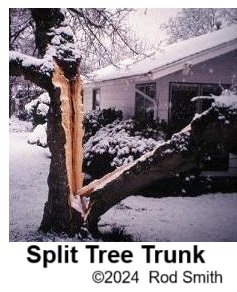 are some simple rules and methods that will help the plant end up looking better, not worse. Unfortunately, these rules do not fit every plant and situation. It is better to first understand the purpose and timing of pruning. Then you can figure out what to do when the
rules do not fit.
are some simple rules and methods that will help the plant end up looking better, not worse. Unfortunately, these rules do not fit every plant and situation. It is better to first understand the purpose and timing of pruning. Then you can figure out what to do when the
rules do not fit.
The purpose of pruning is to control the structure, shape and growth of plants and to promote good health. It is very important to start training a plant when it is young. Pruning can guide a plant into healthy and productive growth and prevent major problems later.
Principles of pruning apply to both trees and shrubs. The main difference is that most trees have a single trunk that lasts
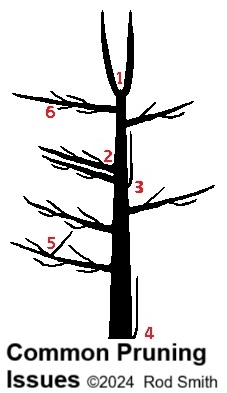 the entire lifetime of a tree while shrubs have multiple branches that might be replaced several times during the lifetime of a shrub. The worst thing that can happen to a tree is to have the trunk split because it had a double trunk.
the entire lifetime of a tree while shrubs have multiple branches that might be replaced several times during the lifetime of a shrub. The worst thing that can happen to a tree is to have the trunk split because it had a double trunk.
Common problems and how to correct them
1. Double trunk, Cut off one trunk.
2. One branch directly above another, Cut off a branch, usually the lower one.
3. Watersprout, Cut it off or tie it down to 45 degree angle.
4. Sucker, Remove soil and cut it off where it sprouts from the root.
5. Branch growing back through tree, Cut off branch.
6. Branch too long, Cut it back to a shorter side branch.
Good structure for most trees means a single trunk with well-spaced branches, which grow outward at a wide angle. Double trunks, crowded branches and upright side branches are likely to develop weak crotches, which will break under heavy loads of fruit, ice or winds. A strong crotch has a ridge of bark in the middle. A weak crotch has a line where the bark disappears into the crotch. The bark is trapped between the branches and prevents the wood from knitting the branches together. This usually happens when branch angles are less than 20 degrees. A narrow crotch might have a ridge of bark when it is young, but develop into a weak crotch as the branches grow fatter.
If a tree has two trunks, one should be removed or cut back to a side branch. Otherwise, the trunk is likely to split in two. If removing one trunk leaves too big of a hole in the tree, another option is to drill a hole through the top of the weak crotch and insert a threaded rod with a large washer and nut on each end to reinforce the crotch. Branches growing directly below another branch should be removed so the branches are far enough apart on the trunk so they do not develop a weak crotch between them.
Also, the branches need to be spaced out vertically on the trunk. The third picture shows a tree with four large limbs at the same height on the trunk. The limbs took all of the water and nutrients flowing up the trunk and the top of the tree was starved to death. Two branches spaced 90 degrees apart are the most that should be at the same height. The main branches on a tree that will grow large should be at least a foot apart in height and at least 90 degrees apart.
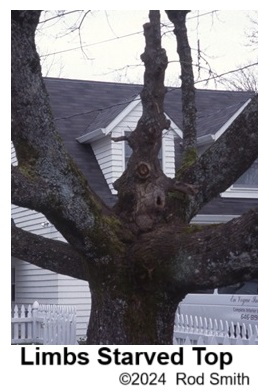 Good shape will depend on the preference of the gardener and on the type of plant and its natural growth pattern: upright, conical, vase-shaped, rounded, spreading or weeping. Most plants will look best if they are allowed to grow in their natural shape with light pruning to keep them more or less symmetrical. A plant can be trained to a shape that is much different from its natural shape. However, it usually is not worth the effort. It is much easier to control the spacing and length of branches and let the plant attain its natural shape. One exception is Japanese style pruning. Heading back cuts, which is cutting off a branch at a bud, are used to develop angular and irregular branching. Shearing, which is making lots of heading back cuts at the same length, create thick tufts of twigs. Thinning out cuts, which is cutting off a branch at the trunk or at another branch, are used to open up the tree and reveal the branching patterns.
Good shape will depend on the preference of the gardener and on the type of plant and its natural growth pattern: upright, conical, vase-shaped, rounded, spreading or weeping. Most plants will look best if they are allowed to grow in their natural shape with light pruning to keep them more or less symmetrical. A plant can be trained to a shape that is much different from its natural shape. However, it usually is not worth the effort. It is much easier to control the spacing and length of branches and let the plant attain its natural shape. One exception is Japanese style pruning. Heading back cuts, which is cutting off a branch at a bud, are used to develop angular and irregular branching. Shearing, which is making lots of heading back cuts at the same length, create thick tufts of twigs. Thinning out cuts, which is cutting off a branch at the trunk or at another branch, are used to open up the tree and reveal the branching patterns.
Two common problems to the shape of trees are suckers and watersprouts. Suckers are branches that grow out of the trunk near ground level and grow straight up. Watersprouts are branches that come out of the trunk or main limbs and grow straight up. They both grow rapidly but usually do not produce flowers or fruit. They also distort the shape of trees and shade out the branches that do produce flowers and fruit. They should normally be removed. Cutting off suckers at ground level will produce two or three times as many suckers. Soil has to be removed and the sucker cut off where it sprouts from the root without leaving a stub. Removing every watersprout in the winter will only produce twice as many more. A few should be left to shade the upper limbs so fewer watersprouts will be produced the following year. Removing the suckers and watersprouts in June or July does not encourage more to grow.
Good shape is also affected by which branches produce the most flowers and fruit. The most productive branches for most plants grow at an angle between horizontal and forty-five degrees. For a particular plant, pay attention to which branches produce the most flowers and fruit. Watersprouts can be trained into productive branches by either cutting them back to a side branch or by tying them down to a thirty degree angle. Branches that droop usually produce small flowers and poor fruit. Shortening and thinning a drooping branch will remove weight so it will spring upwards, or it can be cut back to a more upward growing side branch. If there is no upward growing side branch, a drooping branch can be tied up. After one growing season, the branch will stiffen to stay in its new position.
Symmetrical shape includes both the length of branches and the spacing of branches. Branches that are too crowded should be thinned out. If an area of the plant does not have enough branches, then some branches can be headed back to just above a bud. This will cause the top three or four buds to grow. The top bud will grow the most, so the branch should be cut just above a bud pointing in the direction where a branch is needed. Usually it is best to head back to a bud pointing sideways rather than up or down.
Another way to fill in a thin area is to encourage a new branch to grow from a dormant bud on the trunk. In early spring when the sap is rising, use a knife to cut a half circle, through the bark to the wood, just above a bud. The bud will usually grow. On older wood, dormant buds are often hidden by rough bark. A saw cut through the bark to the wood will usually produce a branch just below the cut.
Heading back the main leader each year will encourage more branches on the trunk. However this will cause the trunk to develop a crook where it is headed back. This might not be desirable for shade and ornamental trees where a straight trunk is preferred.
Promoting health and controlling diseases is another purpose of pruning. Dead and diseased wood should be removed as soon as possible. During the growing season, diseased wood should be cut off six inches below where the disease shows symptoms. Pruning tools should be disinfected after each cut with alcohol or bleach to prevent spreading the disease. Clorox or Lysol wipes also work well.
Pruning can also promote health by opening up the top and center of the plant to allow in light and air. Air circulation helps prevent the start and spread of disease. Light will encourage the production of flowers and fruit even in the center of the plant. The main branches of a tree should be spaced several inches on the trunk and at least 60 degrees around the trunk. If a branch is directly above another, one should be removed. Branches that rub against each other should also be pruned. Branches that grow back through the center of the tree should also be removed.
The season of pruning greatly affects the growth and the flowering of plants. Pruning deciduous plants in the winter when they are dormant will increase the rate of growth that spring. Pruning deciduous plants in the summer will decrease growth the following spring. This
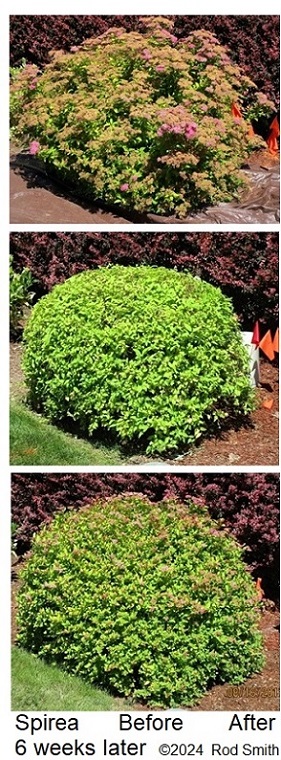 is because of plants' growth cycle. Deciduous plants store food over winter in the roots and trunk. In late winter when the sap rises, sugars are carried up to the buds to feed new growth. Dormant pruning reduces the number of buds so there is more stored food per bud and more growth. In midsummer, plants stop growing and start storing up food for next spring's growth. Summer pruning reduces the number of leaves to manufacture
food so there is less stored food and less growth the following spring. The more that is removed, the greater the change in growth. Pruning in late May or early June neither increases nor decreases the growth rate.
is because of plants' growth cycle. Deciduous plants store food over winter in the roots and trunk. In late winter when the sap rises, sugars are carried up to the buds to feed new growth. Dormant pruning reduces the number of buds so there is more stored food per bud and more growth. In midsummer, plants stop growing and start storing up food for next spring's growth. Summer pruning reduces the number of leaves to manufacture
food so there is less stored food and less growth the following spring. The more that is removed, the greater the change in growth. Pruning in late May or early June neither increases nor decreases the growth rate.
Evergreen trees and shrubs respond differently to pruning than deciduous trees and shrubs since they also store food in their needles or leaves, so pruning removes about the same amount of stored food and buds. Pruning hardly affects the growth rate of evergreens. For needle leaf evergreens, it is not a good idea to shear them from late August to late winter because the cut edge of the needles will turn brown and be unsightly until new growth hides the cut edges.
Mid to late winter, while plants are dormant, is the traditional time for pruning deciduous plants. They are bare of leaves so it is much easier to see the branches. It is an excellent time to prune young plants and fruit trees to encourage vigorous growth. It is better to prune before the sap begins to rise, or the cuts will bleed sap. This does not hurt the plant, but it makes a mess.
May or June is a good time to remove suckers and watersprouts. They are still soft and can be pulled off. They are much less likely to re-sprout if they are pulled off rather than cut off because no stub is left. It is also a good time to remove twigs growing in the wrong direction or to change their direction by tying them.
Summer blooming shrubs, especially roses and spireas, will bloom better if the faded flowers are pruned off. For spireas, a light shearing to remove the old flowers should produce another bloom of flowers several weeks later like the spirea in the picture.
July and early August is the best time to prune deciduous plants that are growing too fast and getting too large. Pruning them at this time will slow down their growth the following year. However, pruning evergreens in late summer might encourage new growth which will not mature before fall rains begin. The new leaves will be more susceptible to disease from winter rains.
Fall and early winter pruning also make plants more susceptible to freeze damage. Late summer and fall pruning should be avoided except to prevent broken limbs from winter storms. However, late summer and fall is a good time to remove dead wood, which is harder to spot during winter pruning, when all the branches are bare of leaves.
If plants have not been pruned for several years, early summer is an especially good time to prune. Pruning deciduous plants then does not speed up or slow down plant growth. Another option is to prune in the winter when branches are easier to see, followed by summer pruning to balance the rate of growth. Also, making large cuts on the trunk and main limbs in the winter is likely to cause the production of clusters of sprouts, so they should be thinned or removed in summer.
For evergreens, branches can be thinned out in winter or summer. Shearing is best done just
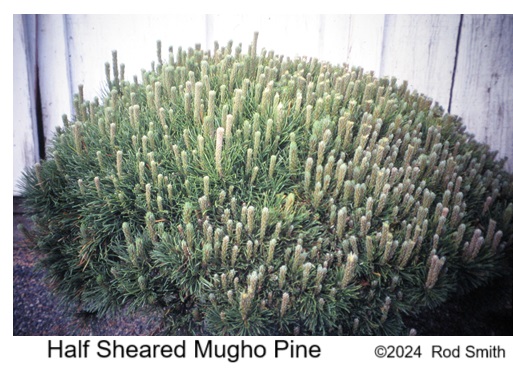 before or after the spring flush of new growth. For many evergreens, a single shearing in early to mid summer is all that is needed. Shearing needleleaf evergreens in late summer or winter is not recommended because it will leave brown edges until they are covered by the new growth.
before or after the spring flush of new growth. For many evergreens, a single shearing in early to mid summer is all that is needed. Shearing needleleaf evergreens in late summer or winter is not recommended because it will leave brown edges until they are covered by the new growth.
Pine trees are very particular about being sheared. All of the buds are clustered at the tip of each branch. If the tips are sheared off, no new growth will occur on that branch and it will eventually die back to a side branch. However, new buds will form if pines are sheared at the soft candle stage, when the needles are just emerging from the new growth. The Mugho Pine in the picture has just been sheared on the right side to keep it evenly rounded. The soft candle stage usually occurs in May or June.
Timing of pruning is also affected by plant's time of flowering. Spring flowering plants produce the flower buds in July and August of the preceding summer. Dormant pruning will remove some of the flowers. Forsythia, lilacs, azaleas and rhododendrons have their flowers on the tips of the branches so winter pruning might remove all of the flowers. Pruning these plants just after they flower will least affect the number of flowers for the following year. Summer flowering plants produce flower buds on current season's growth, so dormant pruning will not remove their flower buds. Many summer flowering plants, especially roses and spireas, will flower more if the old flowers are cut off after they bloom.
It is also important to prune a plant at the time of planting. Bare root plants should have the broken ends of the roots cut off square. For potted plants, if the roots are circling around inside the pot, cut through the outside roots down one or two sides of the root ball, but don't break up the root ball, especially in hot weather. Crowded branches should be thinned and long branches can be shortened. However, it is not necessary to cut back the branches drastically as was formerly recommended.
Occasionally,
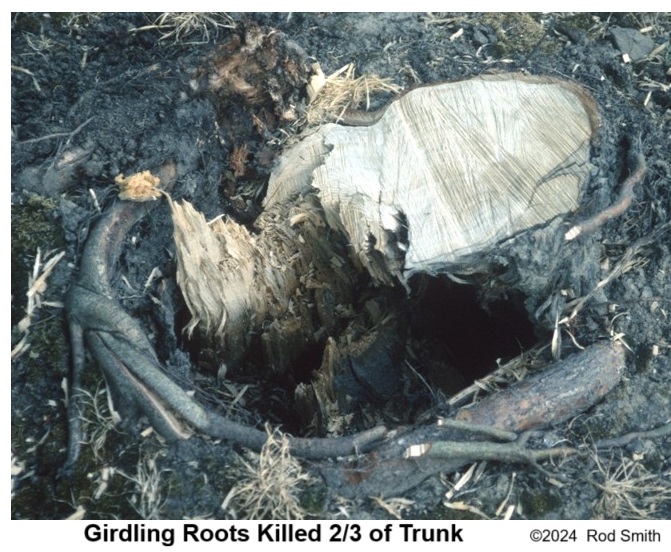 a plant will need root pruning. Sometimes a root will wrap around other roots and strangle them, which stunts the growth of the plant. A circling root killed two-thirds of the
trunk of the tree in the picture. The trunk of a tree should flare out at ground level. If part of the trunk goes straight into the soil, or cups inward, then there is a circling root which is keeping the trunk from growing. The circling root needs to be exposed and removed.
a plant will need root pruning. Sometimes a root will wrap around other roots and strangle them, which stunts the growth of the plant. A circling root killed two-thirds of the
trunk of the tree in the picture. The trunk of a tree should flare out at ground level. If part of the trunk goes straight into the soil, or cups inward, then there is a circling root which is keeping the trunk from growing. The circling root needs to be exposed and removed.
These guidelines are the ideal timing for pruning, but it is never too late to prune, especially if pruning prevents broken branches.
There is an old saying that the best time to prune is when the knife is sharp. Using the proper methods and tools will greatly reduce the time needed to prune, and also the time needed for pruning cuts to heal. A smooth cut will heal much quicker than a ragged cut. Also, a branch cut off close to the trunk will heal over much quicker than if a stub is left. Stubs invite insect and disease problems, and are likely to produce watersprouts. Pruning paint is not needed for small cuts that will heal over in one growing season. A thin layer of pruning paint on large cuts will discourage boring insects and reduce drying and cracking, but a thick layer will interfere with healing. Latex pruning paints are much better for plants than tar based pruning paints.
The main pruning tools are pruning shears, hedge clippers, loppers, saws and pole pruners. All should be kept clean and sharp. The two styles of pruning shears are anvil and bypass. The anvil style might work better for cutting thin, willowy branches and soft stems, but the bypass shears are better to get into crowded branches and to make a flush cut. Both will cut easier if the branch is bent away from the blade to reduce pressure on the blade.
Pole
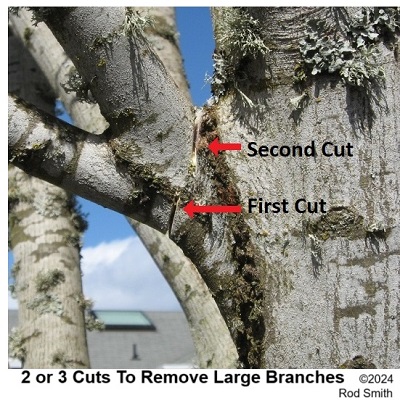 pruners are handy to extend your reach up to ten feet, but they always leave a stub. A sturdy ladder is important for pruning trees. A three-legged orchard ladder is more stable on uneven ground that a regular step ladder. A tarp spread under the plant to catch prunings will make cleanup much easier, especially if shrubs or groundcovers are beneath the plant being pruned.
pruners are handy to extend your reach up to ten feet, but they always leave a stub. A sturdy ladder is important for pruning trees. A three-legged orchard ladder is more stable on uneven ground that a regular step ladder. A tarp spread under the plant to catch prunings will make cleanup much easier, especially if shrubs or groundcovers are beneath the plant being pruned.
When pruning with a saw, branches should be held up until the cut is complete so the bark is not torn. If a branch is too heavy to hold, it should be cut in three steps. First, a cut should be made from the underneath about a quarter of the way through the branch a few inches from the trunk. Second, a cut is made down from above a little beyond the first cut, until the branch breaks off. Finally, a cut is made flush with the trunk. If there is a ridge of bark in the crotch, cut just outside of the ridge and angle the cut outward slightly so the wood of the trunk is not cut. However, if a branch has formed a collar where it attaches to the trunk, cut off the branch flush with the collar, not flush with the trunk.
It is a good idea to tie a rope around a heavy branch to control its fall when it is cut so it does not hit things such as the ladder you are standing on. It would be wise to watch Tree Cutting Fails on YouTube.com to see many of the things that can go wrong.
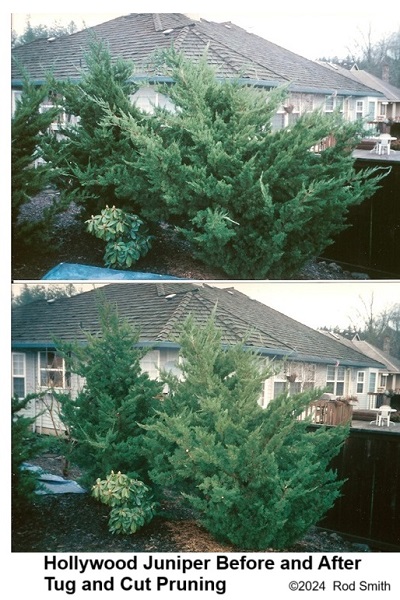
To reduce the size of a plant, a simple technique that works on everything is the Tug and Cut Method. I tug on the longest branches to reveal the side branches, then I use hand pruners to cut the longest branches back to a shorter side branch, preferably a side branch growing in about the same direction. The branch often snaps back into the shrub so the cut is hidden. Sometimes it helps to hold the branch out of the way to see what the plant will look like without it before cutting it off. This is repeated until the plant is the desired size and shape. The ends of the shorter branches are left uncut. This might take more time than shearing but the plant looks more natural.
The Hollywood junipers pictured here were pruned by the Tug and Cut Method. Notice that the plants are roughly the same shape after pruning but are considerably smaller. The longest branches are cut back to a shorter side branch. Deciduous shrubs can be cut back as far as desired, although removing more that a fourth of the twigs in the summer may stunt the plant, and in the winter may cause excessive watersprouts. Needleleaf evergreens should never be cut back to bare wood. Some green needles need to be left to produce new growth. Since twigs are cut to side branches, pines can be pruned any time of year without causing dead stubs or the brown cut edges that shearing causes.
The first rule is never top a tree, because it does not change the basic shape of a tree. It only creates a crooked, funny shaped tree. If the height of a tree needs to be lowered, cut back to a shorter upward growing branch which will grow into the new top.
Start by studying the tree or shrub to see what you want to remove and what you want to keep. Then, start pruning on the backside of the tree or bush. Sometimes it is hard to see how a tree or shrub needs to be pruned until you open it up, so start where it is not so obvious while you are learning. Start with smaller cuts instead of removing a large limb. You can always prune off more, but you cannot put it back.
When pruning, it is best to prune in this order. First, remove any dead or diseased wood. Sterilize the tool with bleach or Lysol after each cut to prevent spreading disease. Next, check the trunk for weak crotches and crowded branches and correct them. Then, remove suckers and prune or tie down watersprouts. Next, remove branches that are crossing over or are directly above or below another branch. Then, prune branches that are drooping. Finally, thin out branches which are crowded, starting at the center of the plant and working outward to the twigs. If two limbs are crowding each other, remove some branches from both limbs instead of all from one limb.
Trees will look better if the lower limbs have a clean underline, except for weeping trees. Remove the branches that hang from the bottom of the limbs. Some trees will look better if the upward and downward growing branches are removed, but sideways growing branches are left to create layers. This is especially appropriate for Japanese maples and also works very well for dogwoods.
Plants are pruned differently when fruit production is more important than appearance. Fruit trees are pruned more severely to encourage larger fruit. A rule of thumb is to take one branch, leave one branch. All of the one year old caneberry canes are removed every summer and almost all of the two year old grape vines are removed every winter.
Peaches, nectarines and apricots produce flowers and fruit on the twigs that grew the year before, so a few older branches are removed and young twigs are kept. Apples and pears produce much of their fruit on spurs, which are slow growing twigs on older wood. The strongest growing twigs are cut back to 4 leaves in late July or early August. Two of the buds are likely to grow into fruit spurs. Removing these outer twigs lets more light into the center of the tree to keep the fruit spurs healthy.
Another option for pruning fruit trees is to prune in late spring when fruit is developing. Then, it easy to tell which branches are most productive so the least productive branches are removed when there is crowding. Also, watersprouts can be removed at the same time without encouraging more to grow.
Blueberries are easier to prune because the flower buds are much larger than leaf buds. Save
 the branches with fat buds unless they are very crowded. Cut back spindly branches with no fruit buds to an inch long to encourage stronger growth and more flowers next year.
the branches with fat buds unless they are very crowded. Cut back spindly branches with no fruit buds to an inch long to encourage stronger growth and more flowers next year.
Caneberries, that is, raspberries, blackberries, and marionberries, have their best crop when the canes are one year old. Cut off all of the old canes back to ground level right after harvest to allow the new canes to grow strong. In late summer, new canes are gathered into bundles and trained on wire trellises.
The most productive way to train grapes is cane pruning. Only the trunk is permanent. For European
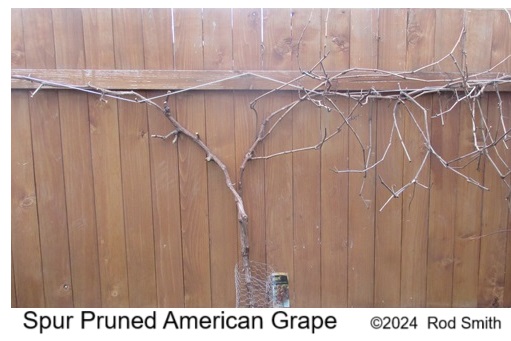 grapes, each winter two vines that grew the previous summer are trained on the bottom wire and the rest of the vines are cut off. The new vines that grow are trained upward between pairs of wires. Vertical training makes them grow more vigorously. For American grapes, two or four canes are trained horizontally on wires and the new vines are not supported since American grapes grow much more vigorously than European grapes.
grapes, each winter two vines that grew the previous summer are trained on the bottom wire and the rest of the vines are cut off. The new vines that grow are trained upward between pairs of wires. Vertical training makes them grow more vigorously. For American grapes, two or four canes are trained horizontally on wires and the new vines are not supported since American grapes grow much more vigorously than European grapes.
Spur pruning is a simpler way to train grapes. A vertical trunk with two horizontal arms growing out from it to make a T shape is permanent. In the winter, the vines that sprout from the T are cut back to one or two buds. The new vines of European grapes are trained upward between pairs of wires but the new vines of American grapes are allowed to spread horizontally without any support. In early summer when it is obvious which buds will produce flowers, each new vine of American grapes can be cut off a few leaves past the last flower bud so they do not get so tangled.
The hardest part of pruning is knowing when to stop. It may be necessary to leave even some drooping or crowded branches to avoid over pruning. Pruning off more than a fourth of the twigs and small branches is likely to be too much. Over pruning in winter will cause many watersprouts to grow the following summer. They should be removed in June. Over pruning during the summer will stunt a plant's growth.
The other indication of over pruning is the reaction of the neighbors. If they say, "You really pruned that tree," then it was probably over pruned. A well pruned plant will look attractive, not butchered.
Pruning is a combination of art and science. The art requires an appreciation of shape and proportion. It is mostly a matter of personal preference and it will vary considerably from one gardener to another. The science requires a careful observation of how plants grow and how they respond to pruning. Both the art and the science of pruning can best be learned by years of practice.
It takes at least five years to become an expert pruner. It takes time to observe how plants respond to pruning. It also takes that long to make enough mistakes to learn from.
Home Page
Site Map
Rod's Garden Pruning
Seasonal Pruning Guide
Tree Fruit and Small Fruit Tips
Trees and Shrubs in the Landscape
Pest Control
Plant Nutrients